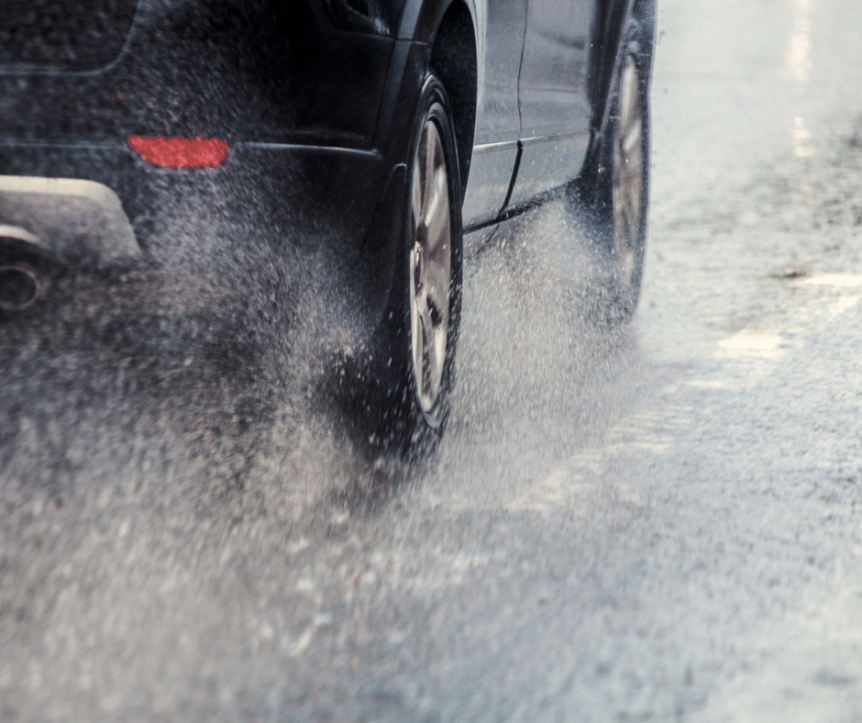Even after this year’s gorgeous autumn, Vancouver winter still looms! As the season’s shift, the temperature drops and the rain begins, it’s important to be on top of your car’s tire health to avoid hydroplaning or getting caught in an accident. Whether you’re new to driving or a seasoned driver, here’s what you can do to prepare for the rainy season.
1. Tire Pressure
It is important to check that your tires are at their optimal pressure. Low pressure causes loss of steering control, decreases your car’s efficiency on gas, and increases friction. Optimal tire pressure ranges can be found in three places: the sticker on the driver’s side door, the vehicle’s owner manual or on the fuel door. Generally, most passenger cars have a recommended or optimum pressure of 30 or 32 PSI. So, check that tire pressure if you want to ensure safety and save on rising gas prices!
2. Check your tread
Due to the rain, hydroplaning in Vancouver is an extremely common danger. When tire tread is worn, the risk of hydroplaning is heightened and can potentially cause your car to blowout. Low tire tread can also affect your vehicle’s ability to stop therefore increasing accidents in the rain even more. Ideally your tire tread depth should be 6/32 or deeper, with 4/32 being considered low and 2/32 as unsafe. You can actually keep your tread healthy by making sure your tire pressure is optimal. This is because low tire pressure causes less friction and less wear on the tread.
3. Rotate your tires
Rotating your tires is very important in tire longevity. It is recommended that it’s done every six months or 10,000 to 13,000 kilometers, depending on how much you drive. You rotate your tires by putting the front two directly behind in their same left right positions. The back two tires however will now come to the front crossed, with back left now being placed in the front right quadrant and vice versa. This forward-cross pattern is especially important for front-wheel drive vehicles because the front tires are responsible for acceleration steering and braking, with the front left tire getting the most wear through right hand turns. This rotation distributes wear evenly and better tire health for longer.
4. Don’t overload your vehicle
Tire health can be maintained by having an appropriately weighted vehicle. When a vehicle is overloaded, it can deflate tires by decreasing pressure and wear the tread. Furthermore, it can also make it harder for the tires to respond to steering because there’s too much weight, and in extreme cases cause tire failure and blowout. You can check your vehicle’s safe weight capacity on the sticker in the driver’s door frame.
5. Keep your tires clean
Tires are usually the dirtiest part of your car yet often overlooked when routinely cleaning! Clearing out debris, dirt, break dust, and other grime that’s been picked up can lessen the chance of tire damage and wear. It is recommended your tires are cleaned bi-weekly, with a deeper clean, using tire specific products, every 2-3 months to add a protective coat to your tires. Do not use abrasive cleaners on tires as it will both wear the tread and cause a coating that picks up more dirt.
6. Don’t use mismatched tires
It is especially important to install matching tires and avoid mismatching. This is because installing tires of different characteristics like size, tread patterns, load, and speed ratings, can cause unbalanced vehicle handling. This can cause accidents particularly in bad weather when vehicle handling is especially crucial to safety, as seen with hydroplaning.
With the holiday season quickly approaching, the last thing you need is car trouble or risking the safety of you and those around you. Follow these guidelines for optimal car health.
7. Lights before action
During a dark and rainy season like Vancouver’s winter, it is vital to ensure all your vehicles lights are working. Road visibility is crucial in preventing accidents, as it decreases speed variance among drivers, particularly in foggy conditions. You would do so by parking your car, engaging the hand brake, and checking the daytime running lights (DRLs), headlights, foglights, taillights, turn signals and hazard flashers. If any lights aren’t working, change them immediately. Should a new bulb not remedy the situation, bring your car in for an assessment as it could be a result of corrosion or a more extensive electrical issue.



